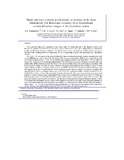| dc.contributor.author | Kampunzu, A.B. | |
| dc.contributor.author | Tombale, A.R. | |
| dc.contributor.author | Zhaia, M. | |
| dc.contributor.author | Bagai, Z. | |
| dc.contributor.author | Majaule, T. | |
| dc.contributor.author | Modisi, M.P. | |
| dc.date.accessioned | 2009-10-06T13:21:26Z | |
| dc.date.available | 2009-10-06T13:21:26Z | |
| dc.date.issued | 2003 | |
| dc.identifier.citation | Kampunzu, A.B. et al (2003) Major and trace element geochemistry of plutonic rocks from Francistown, NE Botswana: evidence for a Neoarchaean continental active margin in the Zimbabwe craton, Lithos, Vol. 71, pp. 431– 460 | en_US |
| dc.identifier.issn | 0024-4937 | |
| dc.identifier.uri | http://hdl.handle.net/10311/381 | |
| dc.description.abstract | The Neoarchaean Tati granite–greenstone terrane occurs within the southwestern part of the Zimbabwe craton in NE
Botswana. It comprises 10 intrusive bodies forming part of three distinct plutonic suites: (1) an earlier TTG suite dominated by
tonalites, trondhjemites, Na-granites distributed into high-Al (Group 1) and low-Al (Group 2) TTG sub-suite rocks; (2) a
Sanukitoid suite including gabbros and Mg-diorites; and (3) a younger high-K granite suite displaying I-type, calc-alkaline
affinities.
The Group 1 TTG sub-suite rocks are marked by high Sr/Y values and strongly fractionated chondrite-normalized rare earth
element (REE) patterns, with no Eu anomaly. The Group 2 TTG sub-suite displays higher LREE contents, negative Eu anomaly
and small to no fractionation of HREE. The primordial mantle-normalized patterns of the Francistown TTGs are marked by
negative Nb–Ti anomalies. The geochemical characteristics of the TTG rocks are consistent with features of silicate melts from
partial melting of flat subducting slabs for the Group 1 sub-suite and partial melting of arc mafic magmas underplated in the
lower crust for the Group 2 sub-suite. The gabbros and high-Mg diorites of the Sanukitoid suite are marked by Mg#>0.5, high
Al2O3 (>>16%), low TiO2 ( < 0.6%) and variable enrichment of HFSE and LILE. Their chondrite-normalized REE patterns are
flat in gabbros and mildly to substantially fractionated in high-Mg diorites, with minor negative or positive Eu anomalies. The
primordial mantle-normalized diagrams display negative Nb–Ti (and Zr in gabbros) anomalies. Variable but high Sr/Y, Sr/Ce,
La/Nb, Th/Ta and Cs/La and low Ce/Pb ratios mark the Sanukitoid suite rocks. These geochemical features are consistent with
melting of a sub-arc heterogeneously metasomatised mantle wedge source predominantly enriched by earlier TTG melts and
fluids from dehydration of a subducting slab. Melting of the mantle wedge is consistent with a steeper subduction system. The
late to post-kinematic high-K granite suite includes I-type calc-alkaline rocks generated through crustal partial melting of earlier
TTG material. The Neoarchaean tectonic evolution of the Zimbabwe craton is shown to mark a broad continental magmatic arc
(and related accretionary thrusts and sedimentary basins) linked to a subduction zone, which operated within the Limpopo–
Shashe belt atf2.8–2.65 Ga. The detachment of the subducting slab led to the uprise of a hotter mantle section as the source
of heat inducing crustal partial melting of juvenile TTG material to produce the high-K granite suite. | en_US |
| dc.language.iso | en | en_US |
| dc.publisher | Elsevier www.elsevier.com/locate/lithos | en_US |
| dc.subject | Petrogenesis | en_US |
| dc.subject | Continental arc | en_US |
| dc.subject | TTG | en_US |
| dc.subject | Sanukitoid | en_US |
| dc.subject | High-K granites | en_US |
| dc.subject | Zimbabwe craton | en_US |
| dc.subject | Botswana | en_US |
| dc.title | Major and trace element geochemistry of plutonic rocks from Francistown, NE Botswana: evidence for a Neoarchaean continental active margin in the Zimbabwe craton | en_US |
| dc.type | Published Article | en_US |

